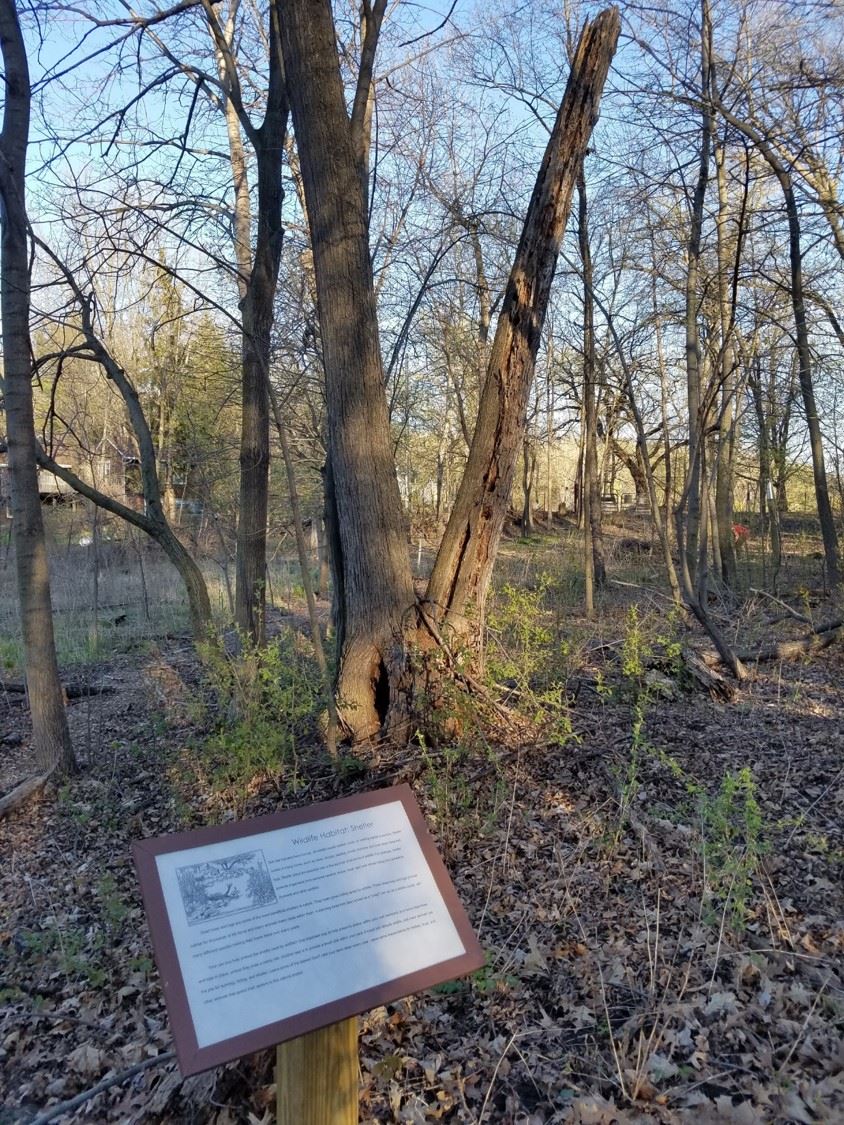By Louise Segreto
There is a housing crisis brewing among birds and critters who make their homes in dead and dying trees. Countless bird and animal species are finding it increasingly difficult locating suitable tree cavities for nesting and caching food. Leading the list of species suffering habitat tree loss are woodpeckers. Red-headed woodpeckers, once an abundant bird, have been severely impacted by the loss of suitable habitat. (We were excited to see one of these beautiful birds at the Chapter this year!) Many other bird species also make their homes in tree cavities including owls, chickadees, nuthatches, tree swallows, flycatchers, wrens, brown creepers, bluebirds; and of course, our much-loved wood ducks. Additionally, numerous small mammals such as bats, squirrels and racoons, and reptiles, amphibians and insects are opportunists, utilizing pre-excavated cavities for food, caching and shelter. Many species of pollinators also utilize dead wood in their life cycles.
Dead and dying trees are essential to forest ecology. They are the condominiums, nurseries and cafeterias of the forest. Such trees are often referred to as “habitat trees.” Other people call them “snags” or “wildlife trees.” Most cavities in trees begin by the work of fungus. Over time, fungus decays wood and makes it soft enough for woodpeckers to excavate. Woodpeckers have reinforced skulls and chisel-sharp beaks. They can work like jack hammers pecking 100-300 times per minute! Smaller woodpecker species need softer decayed wood to excavate. Tree cavities are also created in fire and wind damaged trees which are susceptible to successful fungal growth which in turn leads to exposed soft rotting wood. The Bush Lake Chapter has several habitat trees on the property, and we often leave logs and woody debris on the ground and build brush piles for wildlife.
If you live in the suburbs, I challenge you to take a walk through your neighborhood. More likely than not, you will find very few dead and dying trees. Unfortunately, most homeowners have been taught to regard trees with dead and dying snag like features such as hollow trunks, excavated cavities and dead branches as eyesores. It is such dead and dying trees that offer birds and other wildlife the best sentry posts and cavity opportunities. Unfortunately, suburban aesthetics combined with the fear of increased risk of tree falls on homes and structures lead to the inevitable sound of chainsaws. Making matters worse, “problematic” trees are cut to the stump and trucked away. Fallen trees or cut tree logs from healthy non-diseased trees seldom are left on the ground to decompose for wildlife habitat and plant nursery logs (other plants take root in the moist conditions of the decomposing wood). These landscape management practices, combined with the lack of natural fire burns in suburban communities, and invasive species such as buckthorn are causing fierce competition for the few tree cavities that are available for wildlife.
In light of all of this, I have been considering allowing a dying white oak tree at my home to remain as a “habitat tree.” Here are some ideas to consider:
Trees that are safety hazards to people or structures should generally be removed. Trees that have died from invasive species, such as emerald ash borer, or diseases like oak wilt, should generally be removed in order to keep these problems from spreading to healthy trees. Contact your City forester or certified arborist for help.
Trees to be made into or left as Habitat Trees should be solid enough to withstand the elements. Certified arborists can help “shape” and diagnose good Habitat Trees.
“Topping” a tree (cutting the top off, including branches to decrease wind resistance) can pave the way to a high-quality wildlife tree that can stand for many decades and provide habitat for numerous species.
Unwanted or suitable habitat trees that are still alive can be girdled- use a saw to cut rings around the base of the tree just on the outer bark. Some people remove the bark exposing the living part of the tree. This will effectively kill the tree and in a few years, you may have a habitat tree.
Finally, there is the issue of explaining your Habitat Tree to your neighbors! Over the years, my neighbors have come to enjoy the increase in wildlife due to our wildlife plantings and habitat projects. And, for those who may still be puzzled, I plan on posting my proud oak with a small yellow and black sign: “Habitat Tree.”
If you don’t have space, don’t have dead trees, or don’t want habitat trees- you can do the next best thing- buy or build bat houses, wood duck, bluebird, or other bird houses. These bird houses are replicating tree cavities, and many bird species take to them regularly. Visit the links below for more information.
https://extension.psu.edu/dead-wood-for-wildlife
https://www.nwf.org/Garden-for-Wildlife/Cover/Trees-and-Snags
https://www.nrcs.usda.gov/wps/portal/nrcs/detail/null/?cid=nrcs142p2_008674
https://webapps8.dnr.state.mn.us/volunteer_index/past_issues/article_pdf?id=1798